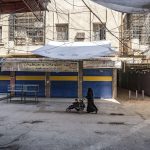COVID-19 has come to Cox’s Bazar, Bangladesh
Health authorities confirmed on March 24 the first case of COVID-19 in Cox’s Bazar, adjacent to the teeming refugee camps where more than 700,000 Rohingya refugees have taken shelter since fleeing a campaign of widespread and systematic violence perpetrated by Myanmar security forces in late 2017.
The Rohingya, along with refugee and internally displaced populations in Syria, asylum seekers on the U.S. border, and the people of war-torn Yemen, are populations whose rights Physicians for Human Rights (PHR) works to protect. And those populations are now at high risk of coronavirus infection. The immense pressures that the pandemic has imposed on developed countries with modern health and sanitation systems, including France, Germany, Italy, and the United States, underscores the deadly danger that those at-risk populations face in areas where health systems are underdeveloped, decimated by armed conflict, or virtually nonexistent. Protection measures for these abandoned populations hinge on timely, cooperative, multilateral action that ensures humanitarian access and medical services, unhindered access to accurate information, and science-based public health approaches that respect human rights.
The price of a failure to protect these populations at highest risk during this pandemic will be calamitous.
The physical reality of the Rohingya refugee camps offers a frighteningly perfect location for mass transmission of the novel coronavirus. The camps are crowded and their residents have limited access to health services or potable water to enable basic sanitation. Standard preventive measures including frequent handwashing are not within reach.
A continent away, the millions of Syrians internally displaced in the country’s northwest are facing the threat of a similar human catastrophe from the COVID-19 pandemic. Conditions there parallel the intensive overcrowding and inadequate sanitation and health services of Rohingya refugee camps. But, shockingly, the deficit in essential health services is the result of a deliberate policy by the Syrian government and its Russian allies to target health infrastructure and health workers – a blatantly unlawful strategy of war.
The months-long brutal assault on the northwest has displaced more than one million women, men, and children, who now cluster in dense urban centers and camps close to the Turkish border. Those camps are the potential epicenter for infection that health officials there warn will constitute a “tsunami” of coronavirus contagion that could kill up to 100,000 people in the coming months without a lasting cessation of hostilities and urgent international assistance. This will require governments that have pledged humanitarian support in the context of the Syrian crisis to deliver rapidly on their lagging promises.
For the millions of Syrian refugees scattered across Jordan, Lebanon, Türkiye, and beyond, the risk presented by COVID-19 is just as significant. With severely limited access to health services, a COVID-19 outbreak in refugee communities could have disastrous consequences. In addition to the threat to their physical well-being, refugees face the added risk of being scapegoated for the spread of the illness in their host communities. As a matter of both public health and human rights, it is extremely important that refugees be fully included in national response strategies to COVID-19 and be able to access adequate and timely health care when needed.
The people of Yemen are also uniquely vulnerable to the COVID-19 infection due to sustained and ongoing attacks on health care infrastructure and health workers over the course of the now-six-year conflict. Warring parties in Yemen have carried out at least 120 violent attacks on medical facilities and health workers, exposed by a joint investigation undertaken by PHR and Mwatana for Human Rights (Mwatana). The routine destruction and repeated occupation of health care facilities and the killing and wounding of medical workers both directly and indirectly contribute to the denial of health care in Yemen. That’s a recipe for heightened vulnerability to coronavirus transmission, and that can only be mitigated by measures including a cessation of hostilities and an urgent deployment of international medical resources and expertise
And along the Mexican border with the United States, tens of thousands of asylum seekers denied access to the United States under the Migrant Protection Protocols (MPP), also known as the “Remain in Mexico” policy, are at high risk of coronavirus infection and without any access to adequate medical care. That’s because they live in unsafe, unsanitary, and inhumane conditions in open-air encampments and shelters. Their legal limbo has worsened due to a March 20 Trump administration directive for US border officials to immediately turn back asylum seekers for the next 30 days without affording them any legal process. The administration sought to justify the order by citing the public health risk of potentially rapid coronavirus transmission in asylum-seekers encampments. Instead, the U.S. government should conduct health screenings of asylum seekers and wherever possible parole them into the United States to relieve the huge numbers of asylum seekers at risk in those encampments.
The price of a failure to protect these populations at highest risk during this pandemic will be calamitous. As the world watches COVID-19 bring to the brink of collapse even modern, well-resourced health systems in places like New York City, a concerted, collaborative worldwide response is essential to confront this truly global challenge with unity and resolve.

